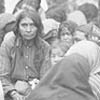 Heritage Community Foundation Presents
Heritage Community Foundation PresentsAlberta Online Encyclopedia
|
The Cree Nation – Customs and Traditions
Food
In contrast, the Plains Cree subsisted primarily by hunting bison, though smaller animals like rabbits and wild fowl were also hunted. Roots and berries served as supplements to their meat-heavy diet. The bison were critical to Plains Cree survival: its meat provided them with food, its hide was used for clothing and shelter, and its bones were used to make tools and weapons. To hunt the bison, the Plains Cree would drive herds of them into fenced corrals where they could more easily be killed. Bison meat was either broiled or dried and pounded with berries and fat to make pemmican. Clothing
Women wore dresses adorned with designs made of quills, beads, or paint. The dresses were usually two pieces of oblong hide or cloth, one on top of the other and tied at the waist by an intricately decorated belt. Dresses extended to the middle of the leg while leggings covered the lower leg. Both women and men wore buffalo robes to cover their upper bodies. Cree children, on the other hand, wore little or no clothing before the age of five. Infants wore diapers made of hide and stuffed with absorbent, sphagnum moss. Moccasins were the standard footwear for everyone, in both summer and winter. The Cree also made use of snowshoes in the winter if snowy conditions required. Headgear ranged from pieces of hide placed around the head to ceremonial headdresses. Shelter
Sources: Darnell, Regna. “Plains Cree.” Handbook of North American Indians, Volume 13, part 1 of 2. Washington: Smithsonian Institution, 2001. Malinowski, Sharon and Anna Sheets, eds., “Cree” from vol. 3, The Gale Encyclopedia of North American Tribes. Detroit: Gale Research Inc., 1998. |
 |
|
For more on the making of treaty 6, visit Peel’s Prairie Provinces.



